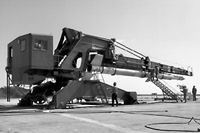Establishment of KSC and Former ISAS
With the improvements in rocket performance, the Japan Sea
was found to be too narrow and a new launch site was sought along the
Pacific coast. At last, Uchinoura in Kagoshima Prefecture was chosen,
and in 1962 construction commenced for a new site, the Kagoshima Space
Center (KSC). The area around KSC, 71 ha in total, is mostly hilly and
offers a broad view eastward.
| In 1964, the Institute of
Aeronautics and the rocket group of the Institute of Industrial Science
of University of Tokyo were merged into a new institute, the Institute
of Space and Aeronautical Science (the former ISAS) attached to the
University of Tokyo. ISAS developed several types of sounding rockets
among which S-210, S-310, S-520, K-9M and L-3H contributed largely
to the progress of Japanese space science. All of them were launched
from KSC. Major sounding rockets, which are now employed for the purpose
of space observation, are the S-310 and S-520. A small rocket
MT-135 has also been developed for meteorological observation. |
 |
 |
K-9M
ISAS developed a two-stage K-9M type rocket, following the K-6 and
K-8. The K-9M series was the most frequently employed sounding rocket
because of its convenient size and capability. Eighty two K-9M's were
launched with a wide range of scientific objectives. |
 |
S-310
The S-310 rocket is a single-stage sounding rocket of 310 mm in diameter
which was developed mainly for use at the Showa Base in Antarctica
by Japan's Antarctic Expedition Team of the National Institute of
Polar Research. |
 |
S-520
The S-520 rocket is a single-stage sounding rocket with fairly flexible
payload capability of 520 mm in diameter. In place of the two-stage
K-9M, the S-520 is playing a leading role among current sounding rockets
in Japan. |
 |
L-3H
Then came the L (Lambda) series. The L-project was supposed to be
a multi-purpose sounding rocket which could reach the inner Van Allen
belt beyond 1,000 km altitude. It was started in 1960 and attained
its goal by a successful flight of L-3-2 in January, 1965. And in
July 1966, L-3H-2 cleared 1,800 km summit altitude. |
|


|
|